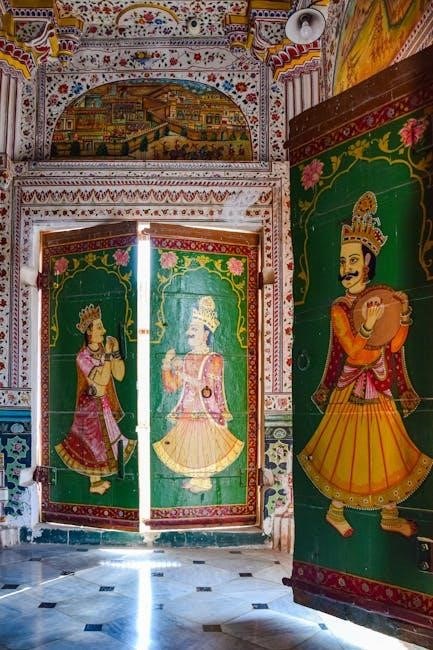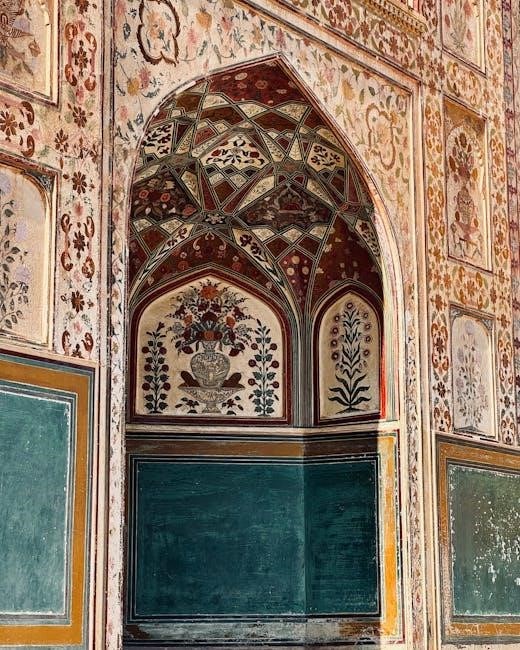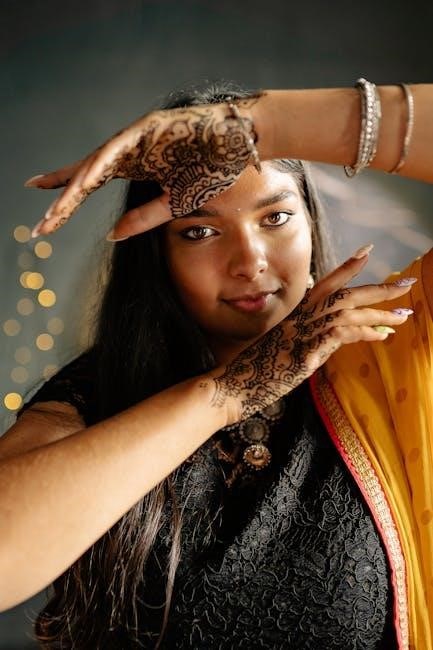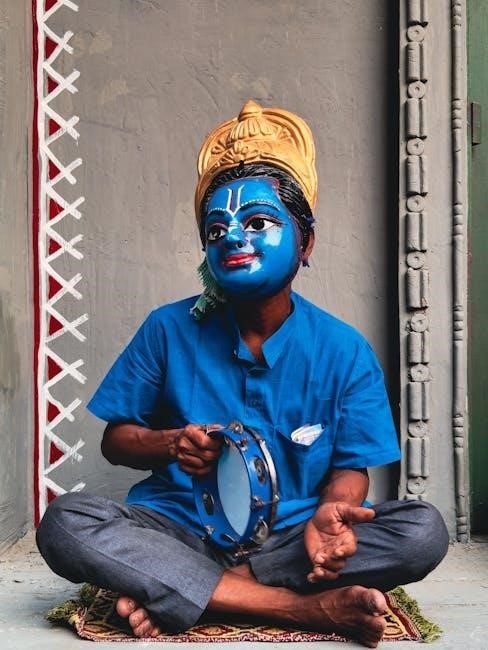Vidya Dehejia, a renowned art historian, has profoundly shaped the understanding of Indian art through her extensive research and analysis of its diverse traditions and cultural significance.
Biography of Vidya Dehejia
Vidya Dehejia, born in 1942, is a distinguished art historian specializing in Indian and South Asian art. She holds a Ph.D. from the University of Cambridge and has taught at prestigious institutions worldwide. Her work spans ancient to modern art, emphasizing cultural and religious contexts. Dehejia has curated exhibitions and authored influential books, including Indian Art (1997), which explores India’s artistic heritage. Her research on Indus Valley cities, Buddhist art, and temple traditions has significantly enriched the field of art history.
Her Role in Promoting Indian Art Globally
Vidya Dehejia has played a pivotal role in promoting Indian art globally through her exhibitions, writings, and lectures. She curated significant exhibitions, such as the Festival of India at the Pierpont Morgan Library, showcasing India’s artistic richness. Her books, including Indian Art, have introduced global audiences to the diversity of Indian artistic traditions. Dehejia’s analysis of Indus Valley cities, Buddhist art, and temple traditions has elevated Indian art’s visibility and appreciation worldwide, making her a key ambassador of its cultural heritage.

Historical Context of Indian Art
Indian art spans over 4,500 years, reflecting diverse cultures and religions. From the Indus Valley civilization to the Mughal Empire, it embodies a rich, evolving cultural tapestry.
Ancient Civilizations and Their Artistic Achievements
Ancient Indian civilizations, such as the Indus Valley, laid the foundation for artistic excellence. Their urban planning, pottery, and seals showcased advanced craftsmanship. The Mauryan and Gupta periods saw the rise of monumental art, including the iconic Buddha images. Cave sites like Ajanta and Ellora exemplify architectural and sculptural mastery. These achievements reflect a blend of functionality, spirituality, and aesthetic brilliance, setting the stage for India’s rich artistic legacy.
Evolution of Art Through Different Dynasties
Indian art evolved significantly through various dynasties, each leaving a distinct imprint. The Mauryan dynasty introduced monumental sculptures, while the Gupta period refined classical art forms. The Mughal Empire brought Persian influences, culminating in masterpieces like the Taj Mahal. Each dynasty built on previous traditions, blending cultural and religious elements to create a rich, diverse artistic heritage that continues to inspire and influence contemporary art forms.

Major Art Traditions in India
Major Art Traditions in India encompass Hindu, Buddhist, and Jain art, each reflecting unique cultural and religious expressions. These traditions highlight India’s rich artistic diversity and historical depth.
Hindu Art and Its Iconography

Hindu art is deeply rooted in religious and mythological themes, with intricate iconography symbolizing divine powers. Deities like Shiva and Vishnu are depicted in various forms, embodying cosmic and human traits. The art often features symbolic motifs, such as the lotus and linga, representing spiritual growth and cosmic order. Temples and sculptures showcase elaborate carvings, reflecting the blend of aesthetics and devotion. Vidya Dehejia’s work highlights how Hindu art transcends mere decoration, serving as a bridge between the mortal and divine realms.
Buddhist Art and Its Influence
Buddhist art emerged in ancient India, depicting the serene image of Buddha and narratives from his life. Cave sites like Ajanta and Ellora showcase intricate carvings and murals, reflecting spiritual and philosophical themes. The art often features symbols such as the wheel of dharma and lotus, emphasizing enlightenment and purity. Vidya Dehejia’s work highlights how Buddhist art influenced regional styles, spreading across Asia and blending with local traditions, leaving a lasting legacy in global artistic expression.
Jain Art and Its Distinctive Features
Jain art is characterized by its intricate carvings, serene sculptures, and emphasis on non-violence. It often depicts Tirthankaras, spiritual teachers, in meditative postures, reflecting austerity and inner peace. The art frequently incorporates symbols like the lotus and wheel of dharma, signifying spiritual growth and cosmic order. Vidya Dehejia’s work highlights how Jain art blends simplicity with sophistication, influencing temple architecture and sculpture across India, while maintaining its unique identity and philosophical depth.

Regional Styles and Their Significance
Indian art exhibits diverse regional styles, reflecting local cultures, traditions, and historical influences. These styles highlight the rich cultural tapestry and unique artistic expressions across different regions.
North Indian Art and Its Characteristics
North Indian art is distinguished by its grandeur and monumental scale, often reflecting the region’s rich historical and religious heritage. The use of red sandstone, intricate carvings, and ornate temple architecture are hallmark features. The art frequently depicts divine themes, showcasing the blending of spiritual and aesthetic expression. Sites like Khajuraho exemplify this style, with elaborate sculptures and precise craftsmanship. The influence of various dynasties, such as the Guptas and Mughals, further enriched the artistic traditions of the region, creating a unique cultural identity.
South Indian Art and Its Unique Elements
South Indian art is renowned for its intricate bronze sculptures, particularly from the Chola period, and the majestic Dravidian temple architecture. The region’s artistic traditions emphasize harmony and spiritual expression, often depicting deities in dynamic poses. The use of vibrant colors and detailed carvings in temples like Brihadishvara exemplify its unique style. The art form also reflects the cultural and religious practices of the region, blending devotion with artistic excellence, creating a distinct identity within Indian art history.

The Role of Religion in Shaping Indian Art
Religion has profoundly shaped Indian art, inspiring spiritual expressions, iconic deities, and symbolic motifs that reflect the nation’s cultural and philosophical heritage.
Hinduism and Its Impact on Artistic Expression
Hinduism has deeply influenced Indian art, inspiring intricate temple carvings, vibrant deities, and symbolic motifs. Its philosophical themes, such as dharma and moksha, are visually represented in sculptures and paintings, reflecting spiritual and cultural values. The divine forms of Shiva, Vishnu, and Devi embody beauty and power, while epics like the Mahabharata and Ramayana provide narratives for artistic expression. Hindu art often blends the sensuous and the sacred, creating a unique aesthetic that resonates with both the divine and human experiences.
Buddhism and Jainism in Artistic Representations
Buddhist and Jain art in India reflect their philosophical emphasis on harmony and inner peace. Buddhist art often features serene depictions of the Buddha in meditation, while Jain art highlights non-violence and simplicity. Both traditions use symbolic motifs, such as the lotus and wheel, to convey spiritual truths. The Ajanta caves exemplify Buddhist narrative art, whereas Jain art often focuses on ascetic themes. These traditions have enriched India’s cultural tapestry, blending spirituality with artistic elegance and profound meaning.
Iconography and Symbolism in Indian Art
Indian art employs intricate iconography and symbolism, with motifs like the lotus and wheel representing spiritual concepts, as explored in Vidya Dehejia’s works, reflecting deep cultural and religious meanings.
The Use of Symbols and Motifs
Indian art is rich in symbols and motifs, such as the lotus, wheel, and cosmic order, which convey deep philosophical and spiritual meanings. These elements, explored by Vidya Dehejia, are central to Hindu, Buddhist, and Jain traditions, often representing divine and universal truths. Intricate carvings, temple art, and manuscripts feature these motifs, showcasing their enduring significance in cultural and religious expression. Dehejia’s work highlights how these symbols bridge the earthly and divine, embodying India’s artistic and spiritual heritage.
The Significance of Iconography in Religious Art
Iconography in Indian religious art, as explored by Vidya Dehejia, serves as a visual language conveying sacred narratives and spiritual truths. From the serene Buddha image to intricate Hindu temple carvings, these icons embody divine qualities and guide worship. Dehejia emphasizes their role in bridging the human and divine, making complex philosophies accessible through art. This visual storytelling is central to religious practice, fostering devotion and contemplation across traditions like Hinduism, Buddhism, and Jainism.
The Art of Cave Sites and Temples
Indian cave sites like Ajanta and Ellora showcase exquisite carvings and sculptures, reflecting spiritual and cultural depth. These temples and caves are masterpieces of ancient Indian artistry.
The Ajanta and Ellora Caves
The Ajanta and Ellora caves are iconic examples of ancient Indian art, featuring intricate carvings, sculptures, and vibrant wall paintings. These sites, dating back to the 2nd century BCE, were once thriving Buddhist and Hindu religious centers. Vidya Dehejia highlights their historical significance, emphasizing the blend of aesthetic and spiritual elements. The caves’ elaborate designs, including depictions of deities and celestial beings, showcase India’s rich artistic heritage and cultural depth, making them unparalleled masterpieces of ancient craftsmanship.
Temple Architecture and Sculpture
Indian temple architecture and sculpture are celebrated for their intricate carvings and symbolic designs, reflecting the spiritual and cultural essence of the subcontinent. Vidya Dehejia’s work highlights the evolution of temple art, from the early cave temples to the grand structures of later periods. Sculptures often depict deities, mythological scenes, and celestial beings, showcasing artistic mastery and religious devotion. These works are not only aesthetic marvels but also windows into India’s rich spiritual and historical tapestry.
The Influence of Foreign Cultures on Indian Art
Foreign cultures, such as Islamic and European influences, significantly shaped Indian art, blending with indigenous traditions to create unique fusion styles and techniques, enriching artistic expression.
The Impact of Islamic Art on Indian Traditions
The arrival of Islamic art in India, particularly during the Mughal Empire, introduced new aesthetic elements like arches, domes, and intricate geometric patterns. These influences blended with existing Indian traditions, creating a unique fusion. The Taj Mahal exemplifies this synthesis, combining Islamic architectural principles with Indian craftsmanship. This cultural exchange enriched Indian art, leading to the development of distinctive styles that reflected both Islamic and indigenous sensibilities, leaving a lasting legacy in India’s artistic heritage.
European Influence and the Colonial Period
The colonial period introduced European artistic influences to India, blending realism and perspective with traditional Indian styles. This fusion created a unique hybrid art form, particularly in painting and architecture. European artists and scholars documented Indian art, preserving its legacy. The colonial era also saw the rise of art schools that merged Western techniques with Indian themes, fostering a new generation of artists. This period significantly shaped India’s modern artistic identity, blending cultural traditions with foreign aesthetics.
The Sensuous Form in Indian Art
Embodied in deities like Shiva, the sensuous form in Indian art is a celebration of beauty and grace, depicted through elegant sculptures and temple carvings, reflecting ancient cultural ideals.
The Depiction of the Human Form
Indian art celebrates the human form as a symbol of beauty and spirituality. From the powerful imagery of Shiva to the graceful poses of celestial dancers, the depiction emphasizes harmony and balance. Idealized forms, often adorned with intricate details, reflect cultural and religious ideals. Vidya Dehejia highlights how these representations transcend physicality, embodying spiritual essence and emotional depth. The sensuous yet serene portrayal of the human figure remains a cornerstone of Indian artistic expression, bridging the earthly and divine. This tradition continues to inspire contemporary interpretations of beauty and grace.

The Celebration of Beauty and Grace
Indian art glorifies beauty and grace through its depiction of the human form, often blending sensuality with spirituality. Elegant sculptures of deities and dancers exemplify this aesthetic, capturing fluidity and poise. Vidya Dehejia emphasizes how these representations celebrate life’s vitality, reflecting cultural ideals of harmony and balance. The art form transcends mere physicality, embodying divine grace and emotional depth. This celebration of beauty remains central to India’s artistic legacy, inspiring admiration and contemplation across generations.
The Art of the Indus Valley Civilization
The Indus Valley Civilization’s art is renowned for its sophisticated urban planning and craftsmanship, as seen in its pottery, seals, and sculptures, reflecting a advanced culture.
The Urban Planning and Artistry of Indus Cities
The Indus Valley cities, such as Harappa and Mohenjo-Daro, showcased advanced urban planning with grid layouts, sophisticated drainage systems, and standardized brick construction. Their artistry is evident in intricately carved pottery, seals, and sculptures, reflecting a culture that valued precision and aesthetics. These cities demonstrate early examples of civic engineering and artistic expression, highlighting the civilization’s ingenuity and cultural sophistication, as analyzed by Vidya Dehejia in her studies on Indian art.
The Artifacts and Their Cultural Significance
The Indus Valley Civilization is renowned for its meticulously crafted artifacts, including seals, pottery, jewelry, and sculptures. These objects reveal a sophisticated society with advanced craftsmanship and symbolic expression. The seals depict intricate designs and possible early forms of writing, while pottery showcases geometric patterns and functional artistry. Jewelry reflects a thriving trade network and aesthetic sensibilities. These artifacts provide insights into the cultural, religious, and social practices of the Indus people, highlighting their ingenuity and artistic refinement, as explored by Vidya Dehejia in her work.

The Art of the Mughal Empire
The Mughal Empire’s art, blending Indian, Persian, and Islamic influences, flourished under emperors like Akbar and Shah Jahan, producing masterpieces like the Taj Mahal, showcasing intricate designs and calligraphy.
The Development of Mughal Art and Architecture
Mughal art and architecture flourished under emperors like Akbar and Shah Jahan, blending Indian, Persian, and Islamic styles. The period saw the rise of intricate designs, calligraphy, and the use of marble and Pietra Dura. Vidya Dehejia’s work highlights how Mughal patronage transformed Indian art, creating iconic structures like the Taj Mahal, which exemplify the synthesis of cultural and artistic traditions, leaving a lasting legacy in Indian art history.
The Taj Mahal as a Masterpiece of Indian Art
The Taj Mahal, a pinnacle of Mughal art, embodies architectural elegance and emotional depth. Commissioned by Shah Jahan, it symbolizes eternal love and spiritual harmony. Vidya Dehejia’s analysis highlights its intricate marblework, calligraphy, and perfect proportions, reflecting the synthesis of Indian, Persian, and Islamic aesthetics. The monument’s ethereal beauty and historical significance make it a cornerstone of Indian art, celebrated globally for its timeless appeal and cultural richness.

The Legacy of Vidya Dehejia’s Work
Vidya Dehejia’s work has left a lasting impact on Indian art history, inspiring modern scholars and ensuring her research remains relevant and foundational for future studies.
Her Influence on Modern Art Historians
Vidya Dehejia’s meticulous research and interdisciplinary approach have set a benchmark for modern art historians, inspiring them to explore India’s artistic heritage with depth and nuance. Her work bridges ancient traditions and contemporary scholarship, offering fresh perspectives on iconography, symbolism, and cultural context. By emphasizing the interconnectedness of art, religion, and history, Dehejia has empowered a new generation of scholars to reinterpret and appreciate India’s rich artistic legacy, ensuring her ideas remain central to ongoing discourse.
The Continued Relevance of Her Research
Vidya Dehejia’s research remains pivotal in understanding India’s artistic heritage, offering insights into its cultural and historical significance. Her work continues to inspire scholars and enthusiasts alike, providing a foundation for contemporary studies. By bridging ancient traditions with modern perspectives, Dehejia’s scholarship ensures that Indian art’s rich legacy remains accessible and relevant today, fostering a deeper appreciation for its enduring influence on global art history and cultural discourse.
Conclusion
Vidya Dehejia’s work underscores the sensuous form and cultural significance of Indian art, blending spirituality with aesthetics, leaving a lasting impact on modern art historical understanding.
Summary of Key Points
Vidya Dehejia’s work highlights the richness of Indian art, spanning over 4,500 years, from the Indus Valley to the Mughal Empire. Her analysis bridges spirituality and aesthetics, emphasizing the sensuous form, iconography, and cultural significance of artifacts. Dehejia’s research underscores the influence of Hinduism, Buddhism, and Jainism, while also exploring foreign impacts like Islamic and European styles. Her contributions remain vital, inspiring modern art historians and enriching global understanding of India’s artistic legacy.
The Enduring Importance of Indian Art
Indian art’s enduring importance lies in its timeless blend of spirituality and aesthetics, reflecting the subcontinent’s rich cultural identity. From ancient Indus Valley urban planning to Mughal masterpieces, it embodies diverse traditions and influences. Vidya Dehejia’s work highlights its global relevance, showcasing how Indian art continues to inspire and educate, bridging past and present while fostering cross-cultural understanding and appreciation of its profound legacy.

References and Further Reading
Recommended books include Vidya Dehejia’s works on Indian art, published by Phaidon Press. Online resources like the Digital Library of India offer extensive access to her research and related articles.
Recommended Books and Articles
Key works by Vidya Dehejia include Indian Art, published by Phaidon Press, and Looking Again at Indian Art (1899). Her analysis of Indus Valley art and temple architecture is seminal. The Digital Library of India offers free access to her writings, such as Looking Again At Indian Art (Item 2015.1425). Online archives like the Internet Archive (archive.org) provide digital versions of her books, ensuring accessibility for global scholars and enthusiasts of Indian art history.
Online Resources and Digital Archives
Online platforms like the Internet Archive and Google Scholar offer digital versions of Vidya Dehejia’s works, including PDFs of her books and articles. The Digital Library of India provides free access to her seminal writings, such as Looking Again At Indian Art. Institutional repositories and academic databases like JSTOR also host her research, making her contributions to Indian art history accessible globally. These resources are invaluable for scholars and enthusiasts exploring her insights on Indian art traditions and cultural heritage.
